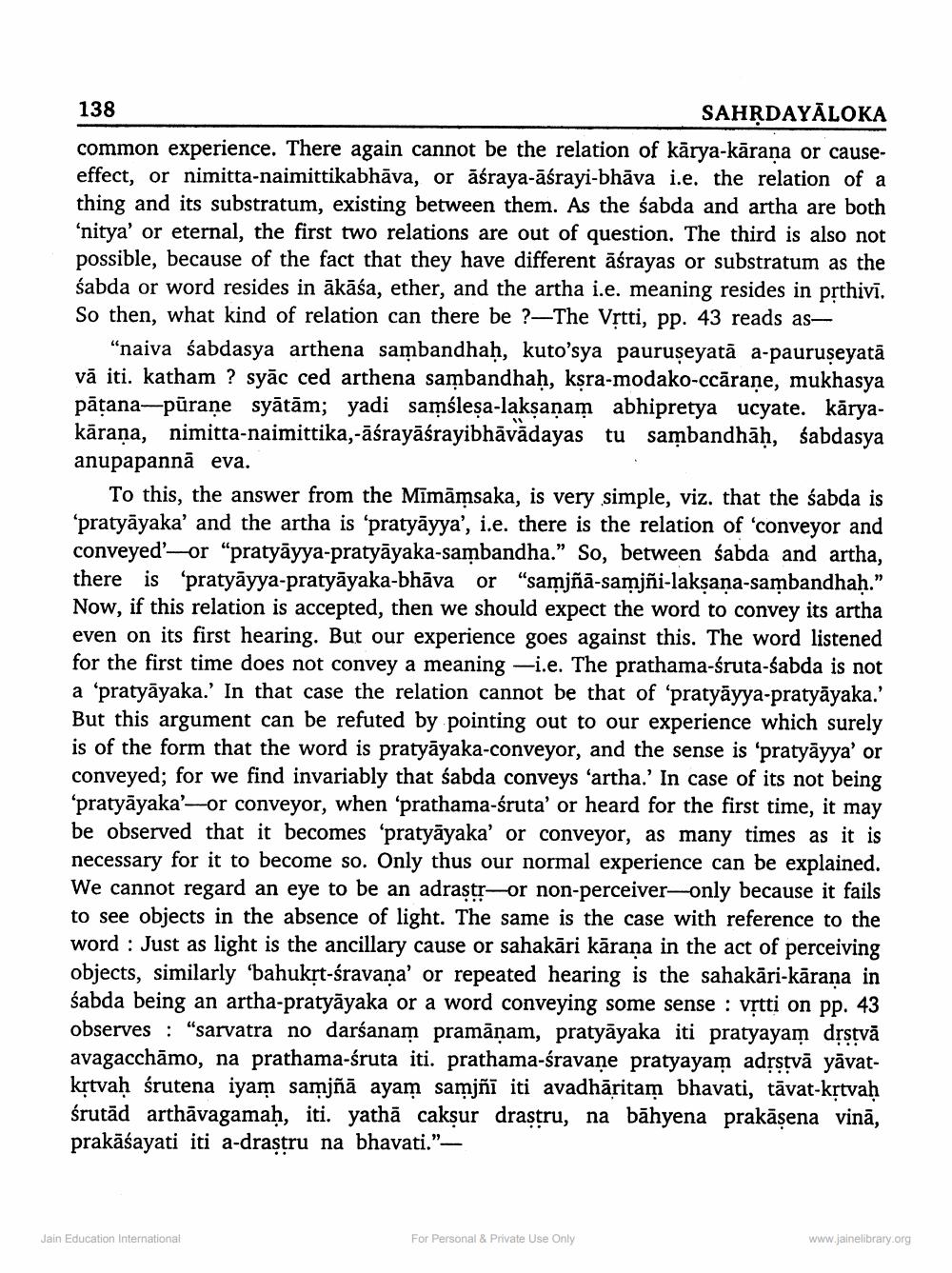________________
138
SAHṚDAYALOKA
common experience. There again cannot be the relation of karya-kāraṇa or causeeffect, or nimitta-naimittikabhāva, or aśraya-āśrayi-bhāva i.e. the relation of a thing and its substratum, existing between them. As the śabda and artha are both 'nitya' or eternal, the first two relations are out of question. The third is also not possible, because of the fact that they have different aśrayas or substratum as the sabda or word resides in ākāśa, ether, and the artha i.e. meaning resides in pṛthivi. So then, what kind of relation can there be ?-The Vṛtti, pp. 43 reads as
"naiva śabdasya arthena sambandhaḥ, kuto'sya pauruṣeyata a-pauruṣeyatā vā iti. katham ? syac ced arthena sambandhaḥ, kṣra-modako-ccāraṇe, mukhasya pāṭana-pūraṇe syātām; yadi samśleṣa-lakṣaṇam abhipretya ucyate. kāryakāraṇa, nimitta-naimittika,-āśrayāśrayibhāvādayas tu sambandhāḥ, śabdasya anupapannā eva.
To this, the answer from the Mīmāmsaka, is very simple, viz. that the sabda is 'pratyāyaka' and the artha is 'pratyāyya', i.e. there is the relation of 'conveyor and conveyed' or "pratyāyya-pratyāyaka-sambandha." So, between sabda and artha, there is 'pratyāyya-pratyāyaka-bhāva or "samjñā-samjñi-lakṣaṇa-sambandhaḥ." Now, if this relation is accepted, then we should expect the word to convey its artha even on its first hearing. But our experience goes against this. The word listened for the first time does not convey a meaning -i.e. The prathama-śruta-śabda is not a 'pratyāyaka.' In that case the relation cannot be that of 'pratyāyya-pratyāyaka.' But this argument can be refuted by pointing out to our experience which surely is of the form that the word is pratyāyaka-conveyor, and the sense is 'pratyayya' or conveyed; for we find invariably that sabda conveys 'artha.' In case of its not being 'pratyāyaka'—or conveyor, when 'prathama-śruta' or heard for the first time, it may be observed that it becomes 'pratyāyaka' or conveyor, as many times as it is necessary for it to become so. Only thus our normal experience can be explained. We cannot regard an eye to be an adrastr-or non-perceiver-only because it fails to see objects in the absence of light. The same is the case with reference to the word Just as light is the ancillary cause or sahakāri kāraṇa in the act of perceiving objects, similarly 'bahukṛt-śravana' or repeated hearing is the sahakari-kāraṇa in śabda being an artha-pratyāyaka or a word conveying some sense vṛtti on pp. 43 observes "sarvatra no darśanam pramāņam, pratyāyaka iti pratyayam dṛstvā avagacchāmo, na prathama-śruta iti. prathama-śravane pratyayam adṛṣṭvā yāvatkṛtvaḥ śrutena iyam samjñā ayam samjñī iti avadhāritam bhavati, tāvat-kṛtvaḥ śrutad arthāvagamaḥ, iti. yatha cakṣur drastru, na bahyena prakāṣena vinā, prakāśayati iti a-draṣṭru na bhavati."—
Jain Education International
For Personal & Private Use Only
www.jainelibrary.org




